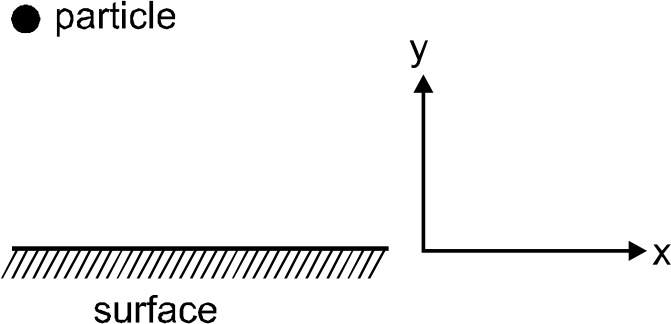A body of mass 3 kg moving with a velocity (2ˆi+3ˆj+3ˆk) m/s collides with another body of mass 4 kg moving with a velocity (3ˆi+2ˆj−3ˆk) m/s. The two bodies stick together after collision. The velocity of the composite body is
17(4ˆi+6ˆj−3ˆk)
17(18ˆi+17ˆj−3ˆk)
17(6ˆi+4ˆj−6ˆk)
17(9ˆi+8ˆj−6ˆk)
The correct Answer is:B
To find the velocity of the composite body after the collision, we will use the law of conservation of momentum. Here’s the step-by-step solution:
Step 1: Identify the masses and velocities of the two bodies
- Mass of the first body, m1=3kg
- Initial velocity of the first body, →V1=2^i+3^j+3^km/s
- Mass of the second body, m2=4kg
- Initial velocity of the second body, →V2=3^i+2^j−3^km/s
Step 2: Write the conservation of momentum equation
According to the law of conservation of linear momentum, the total momentum before the collision is equal to the total momentum after the collision. Thus, we can write:
m1→V1+m2→V2=(m1+m2)→V
where →V is the velocity of the composite body after the collision.
Step 3: Substitute the known values into the equation
Substituting the values we have:
3(2^i+3^j+3^k)+4(3^i+2^j−3^k)=(3+4)→V
Step 4: Calculate the left-hand side
Calculating the momentum contributions from both bodies:
- For the first body:
3(2^i+3^j+3^k)=6^i+9^j+9^k
- For the second body:
4(3^i+2^j−3^k)=12^i+8^j−12^k
Now, adding these two results:
(6^i+9^j+9^k)+(12^i+8^j−12^k)=(6+12)^i+(9+8)^j+(9−12)^k
This simplifies to:
18^i+17^j−3^k
Step 5: Set the equation equal to the right-hand side
Now we have:
18^i+17^j−3^k=7→V
Step 6: Solve for →V
To find →V, we divide both sides by 7:
→V=17(18^i+17^j−3^k)
This gives us:
→V=187^i+177^j−37^k
Final Answer
The velocity of the composite body after the collision is:
→V=187^i+177^j−37^km/s
- Mass of the first body, m1=3kg
- Initial velocity of the first body, →V1=2^i+3^j+3^km/s
- Mass of the second body, m2=4kg
- Initial velocity of the second body, →V2=3^i+2^j−3^km/s
According to the law of conservation of linear momentum, the total momentum before the collision is equal to the total momentum after the collision. Thus, we can write:
m1→V1+m2→V2=(m1+m2)→V
where →V is the velocity of the composite body after the collision.
Substituting the values we have:
3(2^i+3^j+3^k)+4(3^i+2^j−3^k)=(3+4)→V
Calculating the momentum contributions from both bodies:
- For the first body:
3(2^i+3^j+3^k)=6^i+9^j+9^k
- For the second body:
4(3^i+2^j−3^k)=12^i+8^j−12^k
(6^i+9^j+9^k)+(12^i+8^j−12^k)=(6+12)^i+(9+8)^j+(9−12)^k
This simplifies to:
18^i+17^j−3^k
Now we have:
18^i+17^j−3^k=7→V
To find →V, we divide both sides by 7:
→V=17(18^i+17^j−3^k)
This gives us:
→V=187^i+177^j−37^k
The velocity of the composite body after the collision is:
→V=187^i+177^j−37^km/s
Similar Questions
A particle of mass m moving with a velocity (3ˆi+2ˆj)ms−1 collides with another body of mass M and finally moves with velocity (−2ˆi+ˆj)ms−1. Then during the collision
View SolutionA body of mass 2 kg moving with a velocity of 3 m/sec collides head on with a body of mass 1 kg moving in opposite direction with a velocity of 4 m/sec. After collision, two bodies stick together and move with a common velocity which in m/sec is equal to
View SolutionA body of mass 3kg moving with a velocity of 4m/s towards left collides head on with a body of mass 4kg moving in opposite direction with a velocity of 3m/s. After collision the two bodies stick together and move with a common velocity which is
View SolutionA body of mass m moving with velocity 3km/h collides with a body of mass 2m at rest. Now, the combined mass starts to move with a velocity
View SolutionA body of mass 2kg moving with a velocity 3m/s collides with a body of mass 1kg moving with a velocity of 4m/s in opposite direction. If the collision is head on and completely inelastic, then
View SolutionA body of mass 4kg moving with velocity 12m/s collides with another body of mass 6kg at rest. If two bodies stick together after collision , then the loss of kinetic energy of system is
View SolutionA body of mass 4kg moving with velocity 12m/s collides with another body of mass 6kg at rest. If two bodies stick together after collision , then the loss of kinetic energy of system is
View SolutionA particle moving with velocity (2ˆi−3ˆj) m/s collides with a surface at rest in xz–plane as shown in figure and moves with velocity (2ˆi+2ˆj) m/s after collision. Then coefficient of restitution is :

View SolutionA block of mass 2 kg is moving with a velocity of 2ˆi−ˆj+3ˆk m/s. Find the magnitude and direction of momentum of the block with the x-axis.
View SolutionA body of mass m moving with a constant velocity v hits another body of the same mass moving with the same velocity v but in the opposite direction and sticks to it. The velocity of the compound body after collision is
View Solution

